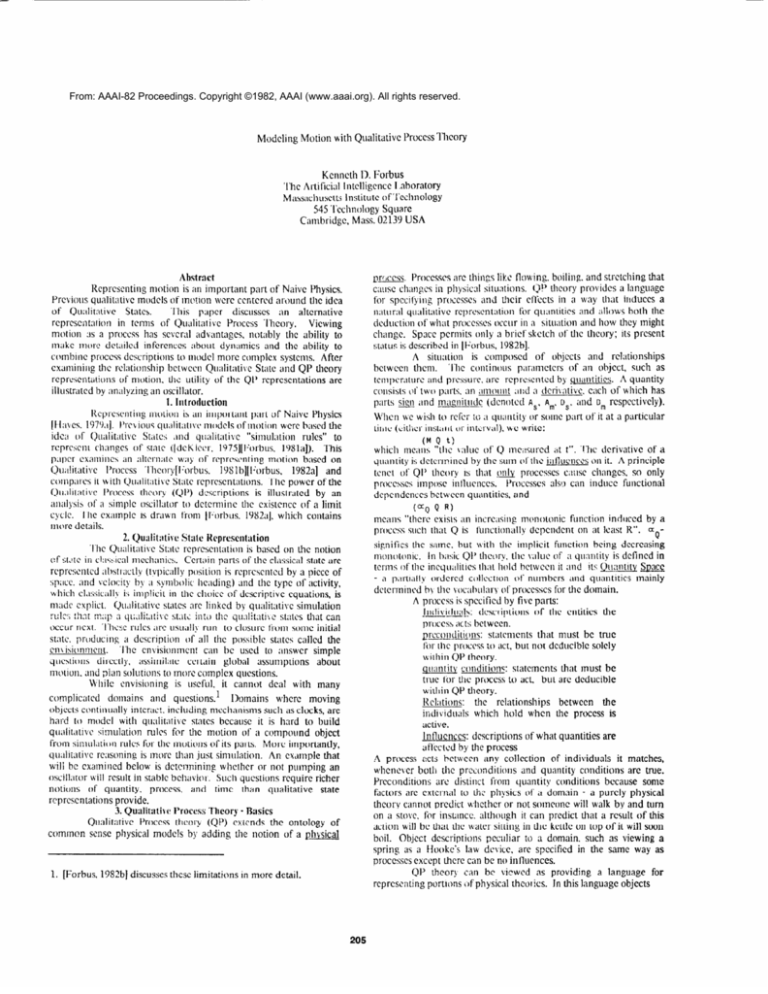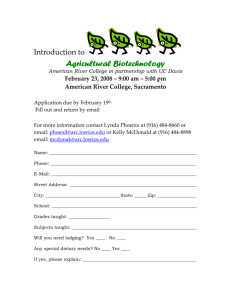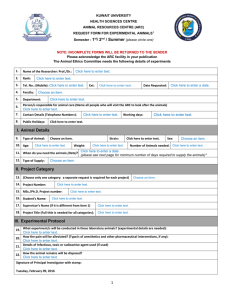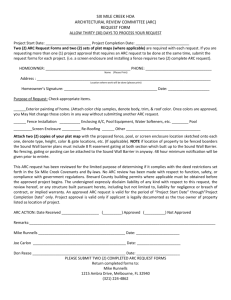
From: AAAI-82 Proceedings. Copyright ©1982, AAAI (www.aaai.org). All rights reserved.
Modeling Motion Hith Qualitative Process Theory
Kenneth II. Forbus
‘I’hc Artificial Intclligcncc I .aboratory
Massachusetts Institute of ‘I’cshnology
545 ‘I’cchnology Square
Cambridge, Mass. 02139 USA
pr!jccss. Proccsscs arc thing5 like flowing, boiling. and stretching that
cause changcc in physical situations. (31’theory provides a language
for specifying proscsscs and their cffccts in a way that induces a
natural qttalitativc rcprc5cntation for quantities and allows both the
deduction of what proccsscs occur in a situation and how they might
change. Space permits only a brief sketch of the theory; its prcscnt
status is dcscribcd in [Forbus, 1982b].
A situation is composed of objects and relationships
of an ohjcct. Such as
bctwccn them. ‘f‘hc cent inous ~ilKllllCtCl3
tcnlpcr,lturc and prcssurc. arc rcprcscntcd by ~~latltitics. A quantity
consibis iIt‘ two IXll‘tS. 3!1 ;11T101!!1,t ;ll!d a dcri\atitc. each of which has
parts u
and ma~nitudc (dcnotcd A~. A,,,.Ds. and Dmrcspcctivcly).
Wlicn UC wish to rCfCi tc; a quantity or sonic part of it at a particular
Liiric(citlicr inst‘lilt or interval), hc write:
(M Q t!
which mcil11b“the \ aluc of Q mc:!surcd at t”. ‘1%~dcrivativc of a
yuLlntity is dctcrmincd by the sum of the i;lllucnccs an it. A principle
tcnct of QI’ Lhcory 1s that only proccsscs C:HISCchanges, SO only
proccxscs impose influcnccs. Processes als!) can induce functional
dcpcndcnccs bctwccn quantities, and
taQ
Q A)
means “thcrc exists i!n increasing monotonic function induced by a
process such that Q is functicmall~ dcpcndcnt on at least I<“. aQsignifies the Si\mC. hut \j ith the implicit function being dccrcasing
monotonic. In basic Ql’ thct)ry. the value of a quantity is dcfincd in
terms of the incqualltIcs ~h:tt hold hctwccn it and its Otlnntltv Smcc
- a partially or&l-cd collcct~on of’ numbers and qiiantitics mainly
dctcrmincd b\ the \ocilhtllar\ of nroccsscs for the domain.
A pi’occss is spccififd 1,; five parts:
!nclividll;l!?: dcccr-iptions of the entities the
process act:; bctwccn.
precondition?: statcmcnts that must be true
fi)r the process to act, but not deducible solely
within QP theory.
ottanlit\j condition<: statcmcnts that must be
true ii)r the pr~)ccss to act, but arc deducible
wiLllin QP theory.
Rckttions: the relationships between the
individuals which hold when the process is
active.
InflucnccF: descriptions of what quantities are
aftcctL’d by the process
A process acts bctwccn any collection of individuals it mate:hes,
whcnc\cr botll the prcconditious and quantity conditions arc true.
Yrccondinons art‘ distinct from quantity conditions because some
factors arc Cxtcrni!l to t.hc>physics of a domain - a purely physical
theory cannot predict whcthcr or not somconc will walk by and turn
on a stove, for instance. although it can predict rllat a result of this
&on will bc that the water sirting in the kettle on top of it will soon
boil. Object descriptions peculiar to a domain, such as viewing a
spring as a Hookc’s law dcvicc, are specified in the same way as
processes cxccpt Lucre can be no influcnccs.
QJ-’ theory can bc viewed as providing a language for
rcprcscnting portions of physical thcorics. In this language objects
Ahstrilct
Rcprcsenting motion is an important part of Naive Physics.
Previous qualitative models of mr\tlon wwc ccntcrcd around the idea
of Qualitative States.
‘Ihis paper discusses Xl alternative
rcprcscntation in terms of Q)ualitilti\‘C Process I‘hcor’y. Viewing
motion 3~ a process has scvcral advantages, notably the ability to
make more dctailcd infcrcnccs about dynamics and the ability to
comhinc process descriptions to model more cornplcx systems. After
examining the relationship bctwccn Qualitative State and QP theory
rcprcscnts[ions of motion. thy\ utility of the QP rcprcscntations are
illustrated by analyzing an oscillator.
1. Introduction
Rcprcccnting motion is an important part of Naive Physics
[I ia\cs. 197X1]. l’rc~iou~ qu,llitatlvc models of motion wcrc based the
idea of Quaiitittivc St,ctcs AI)~ qtialltativc “simulation rules” to
rcprcscnt changes of stale (ldekiccr, 1975][1~o1-bus.19Xlaj). This
piper cxaminch an altrrnatc wit) of rcprcscnting motion based on
Quahtativc Process ‘Ihcory[ f:orbus. 1% 1b][Forbus, 1982a] and
ci~inp,ircs it \\ith Qu<llitati\c State rcprcscntations. ‘l‘hc power of the
C)u,llitativc I’roccss theory (VI’) dcscnptions is illustrated by an
illl;llg~i>of a simple oscill&or to dctcrminc the cxistcncc of a limit
chclc. ‘I‘hc example is drawn from [Forbus. 198233,which contains
more details.
2. ()U:llit:lti\c
St;ltc
i~~pWSCllti~tiOfl
‘Ihc Qualitati\c State rcprcscntation is based on the notion
nf stAC in cla~cnl mechanics. Certain parts of the Cl~lSSiCill
state arc
rcprescnted abst tacLly (tvpically position is rcprc\cntcd by a piccc of
:;p:~cc.and velocity 1~~;I symbolic heading) and the type of activity,
uhich cl,lssicall! is imp!icit in the choice of descriptive equations, is
ma& crxpiict. C)u,llitativc skltcs arc linked by qualitative simulation
rul?, :hnt Ktiii? a qi;,ilititi\c SLIti intc) thC qu,llit:lti:c StatCSthat can
occur next. ‘l‘hcsc rules arc iisudly
run to closure from some initial
stat<. pruduclng a description of all the possible states called the
_cn\i~icrnmcnt. ‘I‘he cnvisionmcnt can bc used to answer simple
quchtions dircctlp. assirnil;llc ccl tAn global assumptions about
m~~ilon,and pian solutions to more complex questions.
C~hilc envisioning is useful, it cannot deal with many
compllcatcd domains and qucstions.l
IIomains whet-c moving
ol$xls
COl~tillUillly
interact. including mcchnnisms such as clocks, are
hard to model with qu;rlitativc states bccausc it is hard to build
qualit,itlvc%uirnulation rules fclr the motion of a compound object
from ~inlulation rules for the motions of its parts. More importantly,
quAitativc reasoning is more tllilll just simulation. An cx,irnple that
wili bc examined below is dctcrmining whcthcr or not pumping an
oscillator will result in stable bchaviol. Such questions rcquirc richer
notiuns of quantity, process, and titnc
than qualitative state
rcprcscntations provide.
3. Qualitath 1:Process Thcorg - Rasics
Qualitative Process theory (QP) cxtcnds the ontology of
common SL’DSC
physical models by adding the notion of a ph\rical
1. [Forbus. 19S2bJdiscusses these limitations in more detail.
205
and smiple processes arc primitivcc, with ~harcd parilmctcrs and
scq ucn!i,ll occiirancc
providing the nicxts of c~tmbination.
,Ibstr;:ctton is proI idcd 1~0th!J!(naming cotnbinariont, and by a type
hic,~~Ch;i
(,~lrhott$t :hrl notatiotxll cttn\~cntiotts fijr the type hicarchy
have
not
been
worked
ou:).
Gcncr,tl
l~fis,
such
3s
involves
direction-towards(C,B,dir)
ditcctil~ll
h simple vocabular4 fat
for hlotion
abstract one dimensional
motion
prcconditiotx
and
contact ;tnd could
hmirlg ~hc abstract
rcprcscnt;ttion
WC ;ISSIIWC
description,
dir)
Pas(B)
t?elations:
Let
(a
Act
be
A,[Vel(B)]
Vel(B))
a number
ACC
(aQ-
Influences:
Am[Fnet(B)]
a)
Q ACC Fnet(B))
Mass(B))
(correspondence
(I+
Vel(B)
(Act
LeJ)
(Fnet(Bl
Act)
taQ
f r Fnormal
(I-
rolling
rcquirc
surface
of niolion
and
Lhc Qtt.tlitati\
c St;W
rcprcscntation.
If
since partial orders i\rc OIIIY Kcll-dc!incd
for one
Fig. 2. Collision Specification
Collide(B,C.dir)
Individuals:
(movable
object
8)
(immobile
object
C)
(and contact(k3.C)
direction-towards(B,C,dir))
Precondition:
QuantityCondition:
Motion(B,dir)
(= (M VeltB)
start)
(- (M Vel(B)
end)))
Relations:
(= (M Vel(B)
during)
zero)
(= duration
zero)
(T direction-towards(C,B,dir)
end)
(T contact(B,C)
end)
: (T <statement>
<time>)
means
; "<statement>
is true during
<time>"
(B*S))
Falong(B~S)
and
ZZLQ))
Moving-Friction(B,S)
B)
individuals:(movable-object
(surface
S)
Preconditions:Sliding-Contact(B.S)
QuantityConditions:Motion(E3,along(S))
Relations:
Let fr be a number
Influences:
(sliding
dimension.
I‘hc atnbiguit}
due to dimcnsiotl;tlity
md symbolic
hcadin~ can bc encoded
by the lack of ordcrine
IWWCCI~ the Quantity
‘I‘his also nlcitns the pl.tcc tnust by cncodcd in the
SpilCC ClCtllCllt~.
nmion
process.
which in [urn ntc;tns th,it an tnctancc of a motion
proccrs in this vl~cLlbttlary will look like a C)ltitlit:tti\‘c
State for the
WilC collection
of l>lilCCS iltld type of tnotion.
‘I‘hC qualitative
sitnttlittion
rules correspond
Lo a compilation
of the limit analysis on
this ncu motion Vl~Cilbtllary.
Frotn this pcrspcctivc
WC can xc the rclntivc strengths
of
rCprcsclltilti0tK.
l-or c\olving
motion
dccct-iptions
the
the two
qualitative
stlltc
rcpmcntatiotl
makes
scnsc,
sinsc
kinctnatic
u)
(I+
rcl,tlions
gconictr~
of the situation
must bc rciimcd
f’tml the preconditions
space by
and 111‘1l>l~d I~LO it Qttmtity
S~XC. ‘l’his rcquircs dcscrihing
1
illlti using
Lhc clcmcnts
in Lhc place vocabulary
il plXc VOC~lb~ilill-1).
‘1’0 induct
an
as Il?c ClctncnK
in IhC posiliim
@anliLy
SpilCC.
ordering
bctH cm
Ihc clct~icnLs
for tmJLion
in LMO and
lhrcc
dimensions
a dirccrion
must
alS(J bc included in the process
l’row~s Ik<criptions of Rlotion ;rrld Acrchxition
Influences:
which
of the
tnoGon and itcccl~t‘ittion ilrc 111~o~I!’ proccsscs that occur,
then the limit itttillqsis fi)r ;t mo\ tttg objccl will only include the
possibilirics
raiscti by d~tlilt1ltC!3.
‘1‘0include the pos4blc changes in
process c,~uscd by kincmiltics (ix.. hilling sotnc~hing)
the rclcvant
not their content.
Acceleration(B,dir)
B)
individuals:(movable-object
Preconditions:
free-direction(B.dir)
QuantityConditions:
(greater-than
Ihc lit>.icct is 1110viIlg in
iltld duration dCfillC lhC
invol\c friction. tix InsLtncc). I’hc x~vantagc of
description
as well ;IS the more dctailcd OIXS is
th;tc Lvcakconclusions cat1 be draMin CICII with litrlc tnformation. If
WCkick something and it isn't blocked. fijr I~SLI~CC, then it will move.
Now WC cittl cxitminc L~C relationship bctwccn this
Uicorics? cljuid a!so bc dcscribcd - 01’ theory constrains the Tel-mof
MotionjE,dir)
individuals:(movable-object
B)
Preconditions:
Free-direction(B.
QuantityConditions:
(greater-than
;IsscI'ISthnt
C to 6. start, end. during
objects involved.
for motion prcscntcd above is quite
‘I’hc process vocabulary
nbstctct. ‘I‘hc particul;lr kind of motion - flyins, sltding. rolling, or
s14inging - is not mctitioncd. ‘I’hcWmotion5 \+3uld bc spccinlizations
of the motion process considcrcd ilbO\ C, dctincd by additioIli4
to the net fiXC and iIl\TrSCly ptUl~~Jrtloll;ll to Iilc lnass of the object.
l-YI-iction occurs when thcrc is sitrfacc cotitxt,
and produces
a force on
the ob~ccl L hich is qu;lhLtti\ cly propcWliotial Lt!lllc nornial forCC and
am in ;I dircction opposite th:tt of’tl~c motion (cncotlcd by I- instead
of I+). Wh11c this dcacription is NC\4lt)niiln, .~ristotcli;tn and ltnpctus
l;ig.I.
tixm
‘I‘hc rypc of collision
cxpansic~tl, ;tnd finally breaking
contnct.
occurs can bc spccificd
by refcring
to the theory of nl;\tctLtls
will serve as an illustr,ttion.l IQire
1 contains the process
spcciticationc for motion ;tnd xcclcration.
‘l’hc motion dcscripGon says thitt motion will occur when a
tnov,tblc (:bJcct is free in rhc ditcction of its iclocity, and th:tt velocity
is tton-7cro. hilotton I$a posijivc influcncc on the position quantity of
an objxt, in ihat if Ihc velocity ts po5iltvc the position will “incrcasc”
and it’ncSatl\ C. IJ~C poGtion will “dccrc;tW”. Acccictxrion
occurs
whL‘t1c1l~lCJv;liJlC r)bLicclilaS a non-%U’otic1 fWcC in ;I ticc direction,
and the inilucncc it provides on velocity is qu;tlit,ttivclq pr0portional
l~ll>SiCiil thcorics,
dir
tc-mporal ,tspccts of an cpisodc in a proccS hictory tb;tt currcsponds
tnodcls
of
to this process occuring. l<vcn our more complicated
collisions appear to use such bchitk iot4 descriptions. such as H
conipor~tid
process consisting
of conlxting the surface. compression,
ciicrgy
conscrv;ttion and Newton’s laws, can bc viewed as constraints on
what proccsscs arc possible. l.ct us SW how thcsc ideas cLtnbc used to
rcprcsent tnotion.
4. A \‘oc;M;try
‘I’he simplest version just
Collisions are complicarcd.
HS illustrarcd in figure 2. Here
a lWCt%l
of vclocit>,
fr)
1. More detailed representations xc tht targcr of work in the
Mcchani5n-t World, \i hich concerns bitnplc dc\ ices such as clocks.
Much work remains. cspccidlly in the gcomctric descriptions
rcq ui red.
2. (klcClosky, 1382J argue5 nnilc theories of motion in our culture
ccrrcspond to i~nlxxr~ C~KOI
ies. not at-isrote!ian theories.
1. [Forbct\.
1981;1]clcscrrh~s the princiljlcs
tnlolvtd
aud defines
plxc \ ocabul;tr!~ for mo:iott thr(lu!Ji spx,: in ;I ~~t~~plc domain.
206
a
constraints arc essential to motion. Its “compiled” nature makes
quslitativc stares in,lppropriate for very simple dcduclions (where
nniy part of a qualit:iti\c st;ltc is known) and more complex questions
involving dynvmics or compound Sq'SlClll~. ‘I’hc ricxt section
illustrates the kind of detailed analysis made possible by the QP
description of motion.
on the quantity spaces and the proccsscs evoked arc the same as the
il;itiA instant. ‘I‘hus WCc;m conclude that an oscillation is occuring.
Note that tIlC pr0CCSSCS IlCCd W bC tIlC SillilC. bCCLIllSC the
prcconditlons might IlilVC changed. J;igurc 3 illuslratcs the process
history for ~hc oscillator.
An additional complexity IS introduced if WC allow for
propcrtics of materials. such as 1.11~
spring being brcakablc. ?l~
ITlCVilIlt CffCClS Of
material composition can bc modcllcd by
introducing clcments into the force quantity SpilCC for the spring
corrccponding to the oc‘curanccs of proccsscs such as breaking and
crushing,
It
in addition to Lhosc for strcL&ing and complcssing.
appeals that a11 assumption is nccdcd to rule out crushing at t3, but
5. An Oscillator
Consider the block 13conncctcd to the spring S in figure 3.
Suppose that the block is pulled back so that the spring is cxtcndcd.
Assume also that the contact bctwccn the block and the floor is
frictionlcss. What happens?
First, the spring object includes:
Relations:
Ds(Lrest(s))=O
Let
ta
;i.e.,
Oispjs)=(- Fi(S)
A(L(s))
brcrking ~‘~11
hc ruled out by an cncrsy argulncnt (csscntially. cncrgy
considerAons lc~i Lo the cclllclusiou th;tt the position of the block at
t5 is no g.1c<ttcr than the p:GLlon at tI. so Lh,ltif it didn’t brcnk then it
WOII’~ hrcak lnlcr). ‘l’hc dct:lils can bc found in [l~orbus, 1982b].
‘10 further an;rlyzc thi> sysLcm. wc must treat the collection
of objects ils ;1 system & the proccqccs th,it occur as ;I conlpound
illlOWS Lhc cxpljcit
proccs\.
Kcplcccnting dw c~NIblIl~lti~JIl
rcprcscnlaLion of‘propcrtics bclonping to the collection, such as the
cncrgk of the system. and propcrtics dclincd over ‘I cycle of the
combination. such as cncrgy losl dnd IlIdxiInurn displaccmcnt. We
can then dcrcrmiiic l!ic conscqucnccs of perturbing the situation in
various u,~gs. III \>i:rtlcular, the rcl,itions for the compound process
include:
is constant
L,e,t(s))
Lrest
Disp(s))
(co?respondence
(Fi(S)
w)
(Disp(s)
w))
ahcrc F: is the internal force due to the composition of the spring.
Since Disp( s) is grcatcr than D.
the spring will cxcrt a force.
I~ccausc the block is rigidly conncctcd to the spring, the net force on
ti?C block will bc ncgativc and since the block is free to mo~c in the
direction of the force. an acccllcration will occur. ‘l’hc nccclcration
will ill turn c~usc rhc vcloolty Lo mo~c from /CFO.which will in turn
CAIFCDs(Pos(B))=-1.
IIy rigid contact, DS(L(S))=-1 ~lnd by tbe a
Q
relation with displaccmcnt. us ( Fnet (8) ) =1. ‘l’hc proccsscs occuring
arc ~m~t~on(l~, -), rclaxing(S, -). act:clcration(II, -). ‘l‘hc next process
litnit occurs when L(s)=L rest(s),
ending Lhc relaxing. ‘Ihc
corrcspondcncc Lclls us the ti~cc on the block l~ccomcs /cro so the
accclcl,ltion will end as well. IHowcvcr, the motion dots not.‘Sctting
a\ldc Lhc dcl;Gls, the next set of proccs\cs <IIT Moti~~n(lI, -),
comprcb$,iSj. and accclcl ation( i$ + ). ‘Ihc only iilnll point in Lhc
qu;lntitq spaces Lhat arc changing is the /cm velocity point (assuming
the spring is unbrcakablc). so the motion will continltc until the
v&city is XI-O. l‘hc conclusion that the next set of proccsscs arc
Motion( 13, + ), rclaxing(S, + ). accclcrntion(l3. + ) and then
Motion(H, -t ), strcLching(S. i ). accclcration(l~, -) fiAlows in the
same way. At the end cvcnt of the last set of‘proccsscs, the orderings
(OcQ
MaxDisp(Dbj)
(correspondence
F(System))
(MaxDisp(Obj)
zero)
Fig. 4. Prows history for the oscillator
Tl
/
T2
I
w))
‘l‘hi4 rclarionship makes it possible to dcducc that if friction were
introduced (i.e.. Ds(E(system))=-1)
LllC O?XiIIk)ll
l~roccss will
cIcl\tirJlly Stop, aud IhAt if Lh\:QStCln i:,~,Uilti>Cdso illirt its ClXrgy
incrcascs (i.e.. D~( E( system) )=I). that thir materials involved in the
Fig. 3. Sliding Mock With Friction
I
(E(system)
-7
T4
\1
Time
207
osci!lstor may break in some way.’ Suppose for cxamplc the
osciliator is subject to friction. but WC pump it wih some fixed
amount of cncrgy per cycle. as would hnppcn in a mechanism such as
a 4ock. Is ~ch a system srablc? ‘I’hc only things wc will assuine
about the friction proccxs in the system is that
Relations:(aQ
E(loss)
Massachusetts, 1975
Forbus, K. “A Study of Qualitative and Geoinctric Knowledge in
‘IX-615. MI?’ AI Lab, Cambridge,
Reasoning ahout M4on”
Massnchusctts, February. 1981
Forbus, K. “Qunlitntivc licasoning about Physical Processes”
Proceedings of IJCAI-7, 1981
Forbus, K. “Qu;rlitativc Process Theory” MIT Al Lab Memo MO.
661,’1-cbruary 1982
l;(y.l?l:j K. “Qua!itativc Reasoning about Space and Motion” to
a~:;xx~:in -A.
Mental M(>dcls ll.‘Gcnt~m and A. Stcvcns, editors.
tiaycs, Patrick J. “‘l’hc N,livc l’hbsics Manifesto” in Fxocrt SvstcmS
b & Microclcctronic w.
cditcd by I>. Michic, Lldinburgh
University Press. May 1979
Hayes. Patrick J. “Naive Physics 1 - Ontology for I.iquids” Memo,
Ccntrc pour ICCctudcs Scmantiqucs et Cognitivcs. Gcncva, 1979
McCloskcy, M. “Naive l‘hcorics of Motion” to appear in Mental
h/lodcls, I). Gentncr and A. Stevens, editors.
E(System))
(correspondence
Influences:(IE(System)
(E(loss)
E(loss))
w)
(E(System) n))
whcrc E ( 1 OS S) is the net cncrgy lost due to friction over a cycle of the
oscillator process. ‘I’hc loss being qunlitlrtively proportional to the
energy is based on the fact that the cncrgy lost by friction is
proportional to the distnncc travcllcd, which in turn is proportional to
the maximum displaccmcnt. which itself is qualitatively proportional
to the energy of rhc system. as strltcd above.
‘t‘hc Iowcr bound fijr the cncrgy of the system is u,
and
an upper bound for cncrgy is implicit in the possibility of the parts
brcakinp. ‘Ihc result, via the aQ stntcmcnt above. is a set of limits on
the qllantity sp‘*cc for E( loss). If wc assume E(pump). the energy
uhich is nddcd to the system over a cycle. is within this boundary
then there will bc a ulue for E(System). call it E( stable), such that:
V
t E
intervals
(implies
(=
(=
(M E(System)
t) (M E(stable)
t))
CM E(loss)
t) (M E(pumP)
t)))
Note rhat E( stab1 e) is unique because a0 is monotonic. If the
encrgv of the syacm is at this poirlt, the inilucnccs of friction and
pumping M111cnnccl ,lnd the sys~cm will stay at this cncrgy. Suppose
:>
(M
C(System)
t)
(M
E(stable)
t))
OVCIsome cycle. ‘l‘hcn hcc~~tisc the loss is qualitatively proportional
to the cncrgy, the cncrgy loss will bc grc,ttcr than the cncrgy gained
by pumping, i.c., Do( E (sys tem) )=-I, and the energy will drop until it
rcachcs t(stahl~). Siinilarly. if F(System) is ksk than E(stahle) the
influcncc of’ friction on the cncrgy WIII bc less tll:rn tjut of the
‘Ihis will continue until the energy
pumpin& thilS Cs(E(System))=l.
!>f thC SySWm
iS qii3
CqLi3l to E(stable).
‘I’hcrcfore for any
pir’ticular pumprng cncrgy there will be a stiiblc oscillation point.
‘i’his iq a qualitarivc vcr$ion of the Froof of the cxistcncc and stability
of limit cycles in the solution of non-linear diffcrcntial equations.
6. Conclusions
l‘his paper has illustrated how motion can bc rcprcscnted
using Qurtlitative Yroccss theory. As the cxamplc indicates, the
notions of quantity and PI-occss it provides allows useful deductions
about svstcms involving motion to be made.
The previous
Qualit;ltivc State rcprcseniation for motion can bc vicwcd as a
sm~piiflcd process vocabulary whcrc kinematic information has been
inrludcd, and qu4itativc simulation rules can bc viewed as a
compilation of the limit analysis 011 this vocabulary. ‘Ihis suggests
thilt for some pu~poscs Qualitative Sta~cs \f*ill be more uscf%l, in that
the mud Qf’ theory limit analysis ulll only cncodc changes due to
dynamics. not kinematics. It should be poscihle to smoothly merge
the two representations, u~g the QP description to decide on the
type of motion, the Qualitati! c State rcprcsentation to determine the
motions possible, and the QP dcscriptilm to prokidc more subtle
analysis to choose bctwccn the altcrnatibes of the qualitative
simulaticn as well as examine other kinds of questions. This of
course is a Lopic for future consideration.
7. References
de Kleer, Johan “Quaiitau\e and Quantitative Knowledge in
Classical Mechanics”
‘1X-352, MIT AI Lab; Cambrjdge,
1. The Tacoma Narrows bridge
eng;nccBrshould know about.
phenomena,
something
every
208








